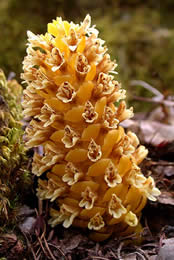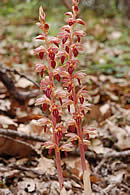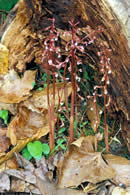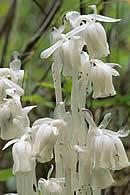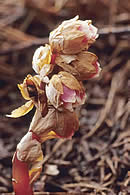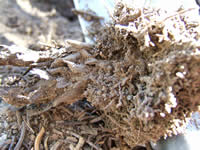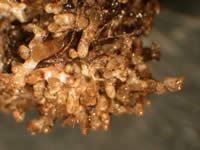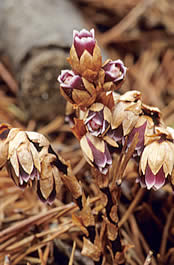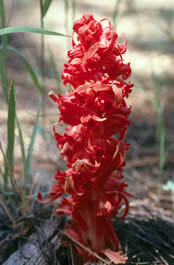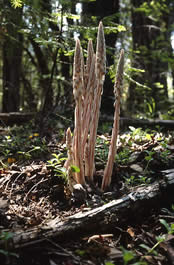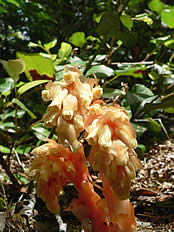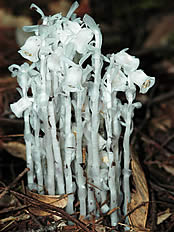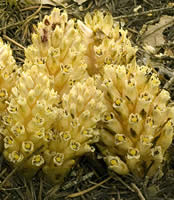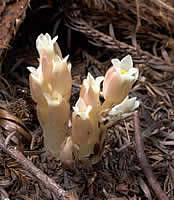USDA Forest Service Celebrating Wildflowers
|
|
|
Mycotrophic Wildflowers - What are they?
To most of us, green and plant go together like peanut butter and jelly on a sandwich. Green plants, since they make their own food from sunlight, water, and carbon dioxide, are called autotrophs, meaning "self-feeding." However, there are plants that are not green and having no chlorophyll, cannot make their own food (organic carbon). These plants are called heterotrophs, meaning "other-feeding", since they must get their nutrition from other organisms Heterotrophic plants are divided into one of two groups, based upon how they obtain their food. The first of these two groups are parasitic plants. As parasites, they obtain their organic carbon from a host green plant directly through the use of structures called haustoria. Wildflowers such as ground cone (Boshniakia hookeri), California broomrape (Orobanche californica) and squawroot (Conopholis americana) possess no chlorophyll, all members of the broomrape family (Orobanchaceae), possess no chlorophyll and are examples of root parasites.
The second of these two groups are mycotrophic ("fungus feeding") plants. These plants obtain their organic carbon from a host green plant by tapping into an intermediary mycorrhizal fungus attached to the roots of the host plant. Many plant families include mycotrophs, especially in the tropics. In temperate North America, the orchid (Orchidaceae) and heath (Ericaceae) families include the highest numbers of mycotrophic genera. Coralroot orchids such as striped coralroot (Corallorhiza striata) and spring coralroot (Corallorhiza wisteriana), are included in but one of many orchid genera that are mycotrophs. All the members of the Monotropoideae subfamily of the heath family (Ericaceae) are mycotrophs such as these two plants: ghost plant (Monotropa uniflora) and sweet pinesap (Monotropsis odorata).
Fun FactMycotrophic wildflowers are sometimes called "fungus flowers." There are two characteristics these plant exhibit that are similar to fungi: their mode of obtaining water, minerals and carbohydrates; and, when the plant pushes up through the soil surface they have the appearance of a mushroom poking out of the ground. In the past, mycotrophic plants were considered "saprophytes," plants that derive their carbon and nutrients from decaying organic matter. This concept has been shown to be incorrect and is largely rejected today. We now better appreciate the relationship between many plant species and the soil fungi living in and around their root systems. Many wildflower enthusiasts understand the symbiotic relationship between trees and mycorrhizal fungi. In this relationship, the hyphae (fungal threads) enter into the roots of the trees. The trees benefit by increasing the surface area of their root system allowing them to absorb greater quantities of water and minerals. In return, the fungus absorbs carbohydrates and other nutrients from the tree. Since they cannot make their own "food," the mysterious mycotrophic wildflowers take this symbiotic relationship between tree and fungus one-step further. Mycotrophic plants "tap" into and parasitize the hyphae of a mycorrhizal fungus by reversing the flow of carbon (derived from the host tree) and other nutrients to meet their survival needs. The unlucky fungus "feeds" the parasitic wildflower and receives nothing in return. Some people have even referred to this 3-way relationship as "mutualism gone badly!" For this reason, the myco-heterotrophs are often said to be "epiparasitic" on other plants. In addition to specialized habitat requirements, recent scientific studies have revealed an under-appreciated feature of mycotrophic plants in the heath family; that is, the extreme level of fungal specificity in many species. The extraordinary snow plant (Sarcodes sanguinea) in the Sierra Nevada of California is exclusively associated with a single species of fungus in the genus Rhizopogon. Pinedrops (Pterospora andromedea), another mycotrophic plant that can co-occur with Sarcodes sanguinea, is associated with another closely related Rhizopogon species. There are eight genera and nine species of mycotrophic wildflowers in the Heath family (Ericaceae) native to the United States. They occur more commonly in the western United States, especially in mixed and coniferous forests. Sweet pinesap (Monotropsis odorata) is the only species that does not occur in the western United States. It is a rare wildflower restricted to rich hardwood forests in the southeastern United States. Wildflower enthusiasts who are hiking through rich hardwood forest in North Carolina may begin to smell violets! Though there are no violets to be seen, a sharp eye may detect the camouflaged sweet pinesap. Several of the mycotrophic wildflowers are quite colorful and beautiful. Snow plant (Sarcodes sanguinea) is a brilliant scarlet red. Sugarstick (Allotropa virgata) is another beautiful wildflower. This common name is derived from the beautiful red and white striping on the flower stalk. Other colorful wildflowers from this group include pinedrops (Pterospora andromedea) and pinesap (Monotropa hypopitys) with their shades of pinkish-red and yellow. One of the more fascinating members of this group of mycotrophic wildflowers is the ghost plant (Monotropa uniflora). Ghost plant is a ghostly white translucent color. Fringed pinesap (Pleuricospora fimbriolata) and the gnome plant (Hemitomes congestum) are the only two mycotrophic species in the heath familiy (Ericaceae) to have a fleshy berry as a fruit. The other mycotrophic species in the heath family have a dry capsule as a fruit. The diminutive California pinesap (Pityopus californica) barely pokes its head up through the leaf litter. The California pinesap is not commonly encountered and is easily over looked. It is the smallest mycotrophic wildflower in the heath family.
For More Information
|
|
| NOTE: PDF format links require the Adobe Acrobat Reader to view. | |
| top | Disclaimers | FOIA | Privacy Policy | Quality of Information | Photo Credits & Use |
Location: http://www.fs.fed.us/wildflowers/interesting/mycotrophic/whatarethey.shtml
Last modified: Tuesday, 10-Mar-2009 12:39:57 EDT

